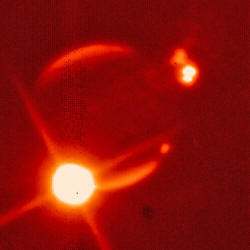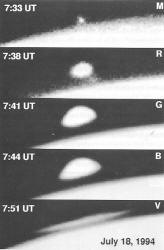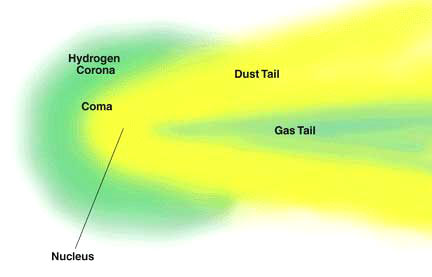|

from
MatterAntimatter Website
The comet was discovered by Eugene &
Carolyn Shoemaker and David
Levy in 1993. Shortly after the discovery, they determined that
comet's elliptical path was on a collision course with Jupiter. The
following year, the comet split into over 21 fragments. Between July
16-22, 1994, the fragments impacted Jupiter's atmosphere and surface
over several million kilometers.
When the fragments hit, the explosions were on the back side of
Jupiter and were not visible on earth.

The aerial explosion of fragment G in the upper atmosphere of
Jupiter is shown below. The explosion produced a brilliant blue-white
flash of light that was a hundred of times brighter than the sun.
The expanding bubble grew hundreds of times in volume. The plume of
gas and debris towered to over 3,000 kilometers into the sky.
Small
black material floated on the top of Jupiter's atmosphere and slowly
settled down into the clouds. Over the months, the upper atmosphere
winds distorted the shape to form a black belt.
 
The energy the antimatter comet was equal to over 200 million
Megatons of TNT. If an antimatter fragments had hit the earth, the
destructive plume would have been five times the diameter of the
earth; and we would not be living on earth today.
Comets
When galactic antimatter enters our solar system, antimatter is
called comets. The dusty-ice model of comets was dispelled when the
European Space Agency spacecraft took pictures of Halley's Comet.
The nucleus was blacker than coal except for the bright area where
matter & antimatter annihilations were producing the light. A recent
analysis of Borrelly's Comet has found that the nucleus exhibits no
trace of water ice or any water-bearing minerals. Since water was
observed in the comet's
 coma &
tail, the water could have only come
from the solar wind and interstellar dust particles. coma &
tail, the water could have only come
from the solar wind and interstellar dust particles.
Over the centuries, scientists have discovered hundred comets
orbiting the sun from light produced from matter & antimatter
annihilations. Within the last decade, scientists have also
discovered hundreds of
sungrazer comets orbit close to the sun.
In the picture on the left, the closer the comet gets to the sun the
brighter the comet's coma and tail becomes. The size of the
coma and
tail increases with the increase in the amount of solar wind &
interstellar dust particles colliding with the nucleus, and within
the coma and nucleus of the comet.
We can observe the coma & tails from the light produced from
matter & antimatter annihilations. The coma and tails are a plasma
containing the solar wind, electrically charged interstellar dust,
comet ions, dust particles, & fragments. The tails points away from
the sun and curves with the solar wind.
When the solar wind & interstellar dust interacts with the comet's
nucleus, we observe the coma, ion, hydrogen, & dusty
tails as shown
in the following pictures.
 
Picture of Comet Hale-Bopp showing a blue plasma tail, by Peter
Barvoets, April 1, 1997
The Nucleus ranges in size from a less than a kilometer to ten
kilometers in diameter. The nucleus is composed of stony & iron
antimatter. The solar wind & interstellar dust blast antimatter ions,
dust particles & fragments off the nucleus.
Interstellar dust
particles can be observed as outburst on the surface of the comet &
anti-tails. The comet's mass ranges from millions to billions of
metric tons of antimatter. If a small asteroid hits the nucleus, the
explosion may split the nucleus into fragments, which is what
happened to the Comet LINEAR 1999 S4.
|
Kinetic
Energy
(30 km/sec) |
Mass
(grams) |
Diameter
(centimeters) |
Matter-Antimatter Energy |
|
4.5 x 10
33 ergs |
10
21 g
(10 15
MT) |
10 7 cm (100 km) |
9 x 10
41 ergs |
|
4.5 x 10
30 ergs |
10 18 g
(10 12
MT) |
10 6 cm (10 km) |
9 x 10
38 ergs |
|
4.5 x 10
27 ergs |
10
15 g (10
9
MT) |
10 5
cm (km) |
9 x 10
35 ergs |
|
4.5 x 10
24
ergs |
10 12 g (10
6 MT) |
10 4 cm
(100 m) |
9 x 10
32 ergs |
|
4.5 x 10
21 ergs |
10
9 g
(10
3 MT) |
10 3
cm (10 m) |
9 x 10
29 ergs |
|
The energy released from matter &
antimatter collisions is 200 million
times larger than the Kinetic Energy
of the particles
[2 times (Speed of light divided by
30 kilometers/sec) 2 ] |
|
|
A Coma is a plasma composed of solar wind, interstellar dust,
antimatter ions, dust particles, & fragments. As comet gets closer
to the sun, the matter & antimatter annihilations increase; the
coma
gets larger from absorbing solar wind & interstellar dust; & the
observed production rates increase.

The observed water in the coma
and tail comes from the solar wind and interstellar dust particles.
The size of the coma increases as it gets closer to the sun and
ranges between 1,000 to 100,000 kilometers in diameter.
|
Solar Wind
The solar
wind is composed of ions, hydrogen atoms,
protons, & electrons. They range in size from
10 -7
centimeters in diameter with a mass of 10
-21
grams to protons & electrons. Their kinetic
energy, mass (density of 2 grams/cm3),
diameters, & matter-antimatter energy are:
Kinetic
Energy
(30 km/sec) |
Mass
(grams) |
Diameter
(centimeters) |
Matter-Antimatter Energy |
|
4.5 x
10
-9
ergs |
10
-21 g |
10
-7 cm |
9 x 10
-1 ergs |
|
4.5 x
10
-12
ergs |
10
-24 g |
10
-8 cm |
9 x 10
-4 ergs |
|
4.5 x
10
-15
ergs |
10
-27 g |
10
-9 cm |
9 x 10
-7 ergs |
|
The energy released from matter &
antimatter collisions
is 200 million times larger than the
Kinetic Energy of the particles
[2 times (Speed of light divided by
30 kilometers/sec)2 ]
Proton
mass is 1.67 x 10-24
grams & electron mass is 9.11 x 10-28
grams |
|
|
The Tails are: Ion, Hydrogen, & Dusty.
-
Ion tails are composed of
high energy ions that are pointed direct behind the comet.
-
Hydrogen
tails are composed of hydrogen & anti-hydrogen and electrons &
positrons that curve with the solar wind.
-
Dust tails are compose of
electrically charged solar wind, interstellar dust plus antimatter
ions, dust and fragments.
The length of the tails gets longer &
bigger as the comet gets closer to the sun and range between a
million to 100 million kilometers in length (distance from the earth
to the sun).
|
Matter and Antimatter Ion Tails
|
|
Kinetic
Energy
(30 km/sec) |
Mass
(grams) |
Diameter
(centimeters) |
Matter-Antimatter Energy |
|
4.5 x
10
-9
ergs |
10
-21 g |
10
-7 cm |
9 x 10
-1 ergs |
|
4.5 x
10
-12
ergs |
10
-24 g |
10
-8 cm |
9 x 10
-4 ergs |
|
4.5 x
10
-15
ergs |
10
-27 g |
10
-9 cm |
9 x 10
-7 ergs |
|
|
|
Hydrogen Tails (Matter & Antimatter
Hydrogen) |
|
Kinetic
Energy
(30 km/sec) |
Mass
(grams) |
Diameter
(centimeters) |
Matter-Antimatter Energy |
|
7.5 x
10
-12
ergs |
1.67 10
-24 |
10
-8 cm |
1.5 x
10
-3 ergs |
|
4.1 x
10
-15
ergs |
9.11 x 10
-28 |
10
-9 cm |
8.2 x
10
-7 ergs |
|
|
|
Dust Tails (Solar & Antimatter Dust
Particles) |
|
Kinetic
Energy
(30 km/sec) |
Mass
(grams) |
Diameter
(centimeters) |
Matter-Antimatter Energy |
|
4.5 x 10
9 ergs |
10
-3 g |
10
-1 cm |
9 x 10
17 ergs |
|
4.5 x
10 6
ergs |
10
-6 g |
10
-2 cm |
9 x 10
14 ergs |
|
4.5 x
10
3 ergs |
10
-9 g |
10
-3 cm |
9 x 10
11 ergs |
|
4.5
ergs |
10
-12 g |
10
-4 cm |
9 x 10
8
ergs
|
|
4.5 x
10 -3
ergs |
10
-15 g |
10
-5 cm |
9 x 10
5 ergs |
|
4.5 x
10
-6
ergs |
10
-18 g |
10
-6 cm |
9 x 10
2 ergs |
|
4.5 x
10
-9
ergs |
10
-21 g |
10
-7 cm |
9 x 10
-1 ergs |
|
The energy released from matter &
antimatter collisions is 200 million
times larger than
the Kinetic Energy of the particles
[2 times (Speed of light divided by
30 kilometers/sec)2]
.
Proton & Antiproton masses are 1.67
10 -24 grams
& electrons & positron masses are
9.11x 10-28 grams
|
|
|
During the last century, Shoemaker-Levy 9 comet broke up and the
fragments. The collides with Jupiter produced 21 explosions
equivalent to over 200 million Megatons of TNT. In 1908, a fragment
from Encke's comet
hit the earth's atmosphere in Russian Siberia and
exploded with an energy of equivalent to over 30 Megatons of TNT.
|







